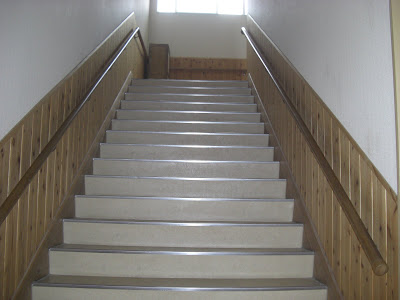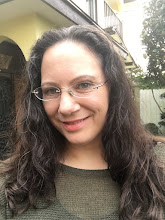Looking at a Japanese Primary School from the outside, there are two big difference:
1. They are usually two or three storeys high. This is because there is less space in Japan. Japan is about the same size as New Zealand, but 120,000,000 people live here! Japan's islands are volcanic and mountainous, but most people live on the flat land by the sea, making it even more crowded.
2. There's no grass! The climate in Japan is very different from that in New Zealand. The summer here is long and hot, and the soil is dryer. So, it's much harder to grow grass. Almost all schools have no grass, just dirt playgrounds. Kids play all their sports on the dirt, including baseball and soccer.
 This is the South Wing. The Library is in here, on the second floor.
This is the South Wing. The Library is in here, on the second floor. The three main wings are in the shape of a 'C'. At a right angle to the South Wing is the Hall. (You can see the South Wing on the right) All Primary Schools in Japan have a great big Hall like this, they use it for indoor sports, concerts, festivals, games and ceremonies.
The three main wings are in the shape of a 'C'. At a right angle to the South Wing is the Hall. (You can see the South Wing on the right) All Primary Schools in Japan have a great big Hall like this, they use it for indoor sports, concerts, festivals, games and ceremonies. Another view of the Hall from the north, with a corner of the South Wing.
Another view of the Hall from the north, with a corner of the South Wing. The North Wing, where all the classrooms are.
The North Wing, where all the classrooms are.  A closer view of the North Wing. In the windows, you can see some of the class names. The first number is the Year, the second number is the class number. 2-2 is on the second floor, third from the left. That's Lena's class - Second Year, Class Two. There are two classes in her year. There are between two and four classes for each year. In the First Year, the class size is about 20 kids. From the Third Year, the class size gets bigger, about 30 kids. Altogether there are about 400 kids at this school.
A closer view of the North Wing. In the windows, you can see some of the class names. The first number is the Year, the second number is the class number. 2-2 is on the second floor, third from the left. That's Lena's class - Second Year, Class Two. There are two classes in her year. There are between two and four classes for each year. In the First Year, the class size is about 20 kids. From the Third Year, the class size gets bigger, about 30 kids. Altogether there are about 400 kids at this school.*Nakatsu city is in the prefecture of Oita on the island of Kyushu. Population 70,000














































